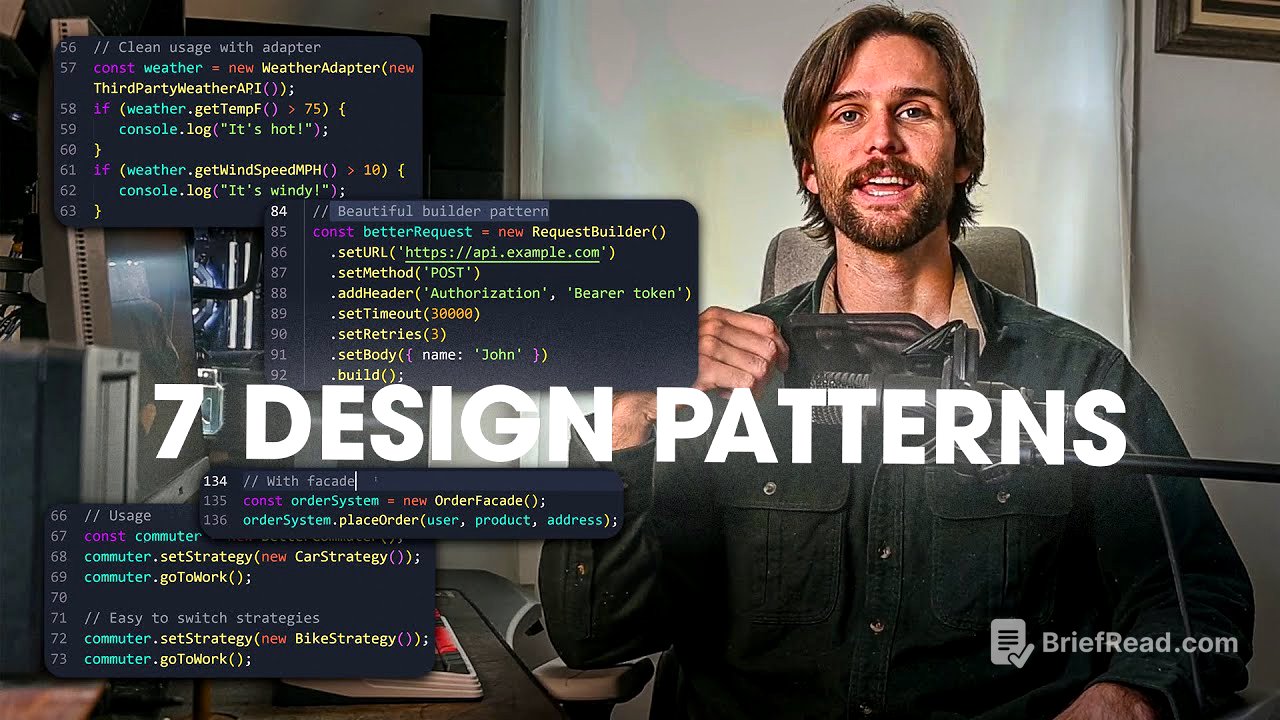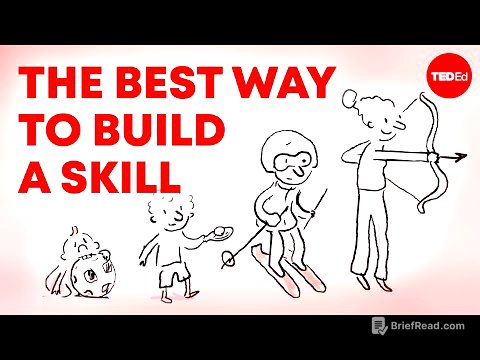TLDR;
This video explains seven software design patterns: Singleton, Builder, Factory, Facade, Adapter, Strategy, and Observer. It categorizes them into creational, structural, and behavioral patterns, providing examples and use cases for each. The video emphasizes the importance of understanding these patterns to solve common programming problems and improve code maintainability.
- Creational patterns focus on object creation.
- Structural patterns deal with object relationships.
- Behavioral patterns handle communication between objects.
3 Types of Patterns [0:00]
The video introduces the concept of software design patterns as solutions to common programming problems, referencing the book "Design Patterns: Elements of Reusable Object-Oriented Software" by the Gang of Four, which documents 23 patterns. These patterns fall into three categories: creational (object creation), structural (object relationships), and behavioral (object communication). The video will cover seven of these patterns.
Singleton Pattern [1:34]
The Singleton pattern ensures that only one instance of a class is created and provides a global point of access to it. It is useful for scenarios like logging systems or database connection pools where a single, shared resource is required. While it guarantees a single instance and global access, it can be difficult to test and requires special handling in multi-threaded environments to prevent multiple instances from being created. The Singleton pattern is likened to a glorified global variable, which can be problematic if overused.
Builder Pattern [3:35]
The Builder pattern is useful when creating objects with many optional parameters or when the construction process involves multiple steps. It allows you to chain methods in any order and skip optional parameters, making the code more readable. Adding new options only requires adding a method to the builder class, without modifying existing code. This pattern is beneficial when constructors have many parameters or when objects need to be constructed step by step, like following a recipe. While it requires more code upfront, it improves code maintainability and readability.
Factory Pattern [5:21]
The Factory pattern centralizes object creation logic, hiding the complexity of creating different types of objects. For example, instead of using multiple new keywords throughout the code to create different types of users (admin, moderator, regular user), a factory class handles the creation based on the specified type. This simplifies the code and makes it easier to modify the object creation process in one place. The downside is the added layer of abstraction and the tight coupling to the factory class, but the flexibility and maintainability gains are worth the trade-off.
Twingate Security [7:47]
Twingate is introduced as a modern replacement for VPNs, providing secure, direct connections to resources without exposing them to the public internet. It allows developers to access staging environments, internal tools, and cloud resources remotely with high performance and security. Twingate can be managed as code with Terraform and Kubernetes, simplifying setup and access control.
Facade Pattern [8:58]
The Facade pattern provides a simplified interface to a complex subsystem, hiding the underlying complexity. It encapsulates a set of complex subsystems behind a single, easy-to-use interface. For example, when ordering something online, the "buy now" button hides the complex processes of payment processing, inventory checks, and shipping calculations. Without a facade, the code would be more complex and repetitive. The downside is that the facade can become a god object if it knows too much and does too much, but it is still better than spreading the complexity everywhere.
Adapter Pattern [12:56]
The Adapter pattern allows you to integrate third-party libraries or APIs that don't match your code's expectations. It acts as a translator between two incompatible interfaces. For example, if a weather API provides data in Celsius and kilometers, but your app expects Fahrenheit and miles, an adapter can convert the data. Without an adapter, you would have to modify your code everywhere you use the API. The downside is that it can be tedious to create adapters for everything, but it is better than spreading the conversion logic throughout your code base.
Strategy Pattern [16:18]
The Strategy pattern defines a family of algorithms, encapsulates each one into a class, and makes them interchangeable. It allows you to choose an algorithm at runtime. For example, a commuter can choose different strategies for getting to work (driving, biking, taking the bus). Without the strategy pattern, you would have a large if-else statement to handle each strategy. The strategy pattern follows the open-closed principle, allowing you to add new strategies without modifying existing code. The downside is that you end up with a bunch of classes, but it is better than a large if-else statement.
Observer Pattern [20:03]
The Observer pattern allows objects to subscribe to events that happen to other objects. When an event occurs, all subscribers are notified. For example, when a YouTube creator uploads a video, subscribers who have clicked the bell icon are notified. Without the observer pattern, you would have to loop through all users and notify them individually. The downside is that you can enter into event callback hell if you go overboard on events, where one event triggers another event, which triggers another event.
Know When to Use Each One [22:49]
The video concludes by emphasizing the importance of knowing when to use each design pattern. It encourages viewers to study, use, and practice these patterns to internalize them.









